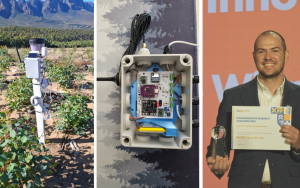
Fire Engineering students apply their knowledge during the Techniques in Fire Engineering practical week.
Systems, Sprinklers, Simulations: Fire Engineering in practice
- The Techniques in Fire Engineering (TFE) module turns classroom concepts into practical skills for safer building design.
- The TFE practical week highlights SU’s commitment to the training of engineers.
Fire Engineering students recently gathered on campus for a one-week practical as part of the Techniques in Fire Engineering (TFE) module. Held in September, the one-week programme transformed lecture-based theory into a high-intensity, hands-on experience.
Split into two groups, students rotated through fire behaviour, detection, smoke management and suppression stations, then translated their measurements into assignments, including modelling their own evacuation of the Engineering building. In addition to operating extinguishers and hose reels, students observed demonstrations of sprinkler and foam systems and conducted cone calorimeter tests to determine ignition and heat-release rates.
And yes, there was room for curiosity: the “burning a Snickers bar” experiment became a crowd-favourite, turning a familiar object into a dataset that sharpened discussions on material composition, surface condition and ignition calculations. Students had to determine whether such food items could serve as the first fuel source in a forensic fire investigation at a food factory.
By the end of the week, students left able to plan small-scale fire tests, interpret system performance, and select modelling approaches that hold up in design reviews.
What students had to say
“Overall, the practical week was an invaluable learning experience. It was also a lot of fun, and seeing fire principles demonstrated in realistic situations made the concepts much easier to understand. The practical sessions brought the theory of fire engineering to life. It was hands-on, engaging, and a reminder of the importance of research, testing and proper design in making buildings safer.” – Aslam H
“TFE Week was a fantastic opportunity to broaden my knowledge and engage with both the technical and practical sides of fire engineering. It was great to interact directly with sprinkler systems, fire alarm and detection systems, and to conduct practical fire testing, including use of the cone calorimeter. The live fire behaviour demonstration was particularly valuable, clearly showing how ventilation and fuel orientation can significantly influence fire growth within a building.” – Stephen M
From theory to impact
The Techniques in Fire Engineering practical week underscores SU’s commitment to producing engineers who can design, model and defend safer built environments. By translating theoretical knowledge into measurable outcomes, students gain the confidence to approach fire safety as both a science and a responsibility.
Offered biennially, the module continues to ignite curiosity and capability in equal measure — and the Faculty already looks forward to welcoming the next TFE cohort in 2027.



